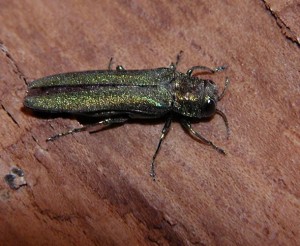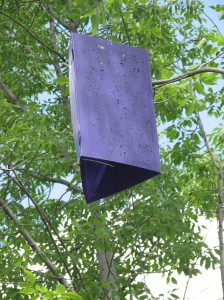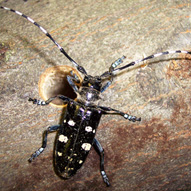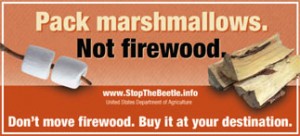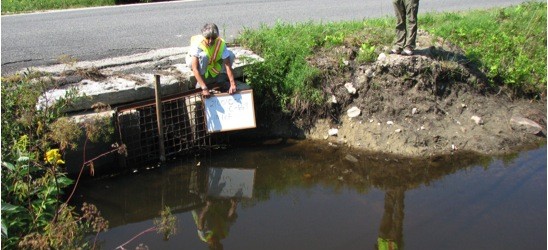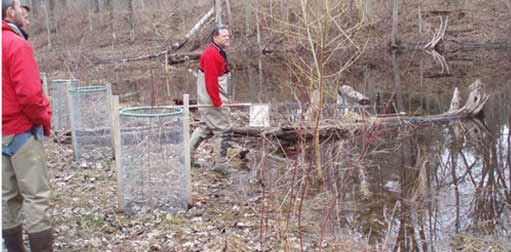What’s Threatening Our Trees? BEAT Presentation at the Harvest Festival
Jane Winn, Executive Director of BEAT, presented a workshop on the Emerald Ash Borer and Asian Longhorned Beetle. The workshop, What’s Threatening Our Trees?, was on Saturday, October 1st at the Berkshire Botanical Garden’s Harvest Festival. The talk provided attendees the opportunity to view specimens of both species as well as wood that had been infested. This can give a good idea of what signs to look for in trees in your neighborhood.
The Emerald Ash Borer is a beetle that attacks ash trees. It was introduced from Asia sometime in the 1990s and was discovered to be attacking trees in Detroit, Michigan and nearby Windsor, Ontario in 2002. Since then, it has spread to a number of states, including New York. It has not yet been found in Massachusetts.
There are intensive efforts right now to determine whether or not Emerald Ash Borer or Asian Longhorned Beetle are in western Massachusetts. You may have seen the strange purple boxes hanging in trees along roads.
These “Barney Boxes” (remember the purple dinosaur?) are there to lure in and catch any Emerald Ash Borers that may be around. In addition, the US Department of Agriculture (USDA) is asking everyone to survey their own property for these insects. The USDA wants to know whether or not you have found any evidence of the beetle. Knowing that you looked but didn’t find anything is very important, too. It’s easy to report your findings on-line at USDA’s Beetle Detectives website.
So how do you tell if you have one of these invaders? The best sources of information are the Beetle Detectives website and Stop the Beetle. The website Beetle Busters has information about both the Emerald Ash Borer and another introduced destructive insect – the Asian Longhorned Beetle.
Trees favored by the Asian Longhorned Beetle are predominantly maples, but infestations have also been discovered in horsechestnuts, poplars, willows, elms, mulberries, black locusts, and a few other deciduous trees. The adults of Asian Longhorned Beetle don’t usually emerge until late July, but you can look anytime for the circular exit holes they leave in the tree – just large enough to slip the eraser end of a pencil into the hole deep enough to cover the metal band. (don’t be tricked by maple tap holes – if you find holes at a reasonable height for maple sugaring, look up the trunk and on the branches to find more holes.) The adult beetles are 1 to 1 ½ inches in length, shiny black with white spots, and have long antennae banded in black and white (longer than the insect’s body). Asian Longhorned Beetles like maple, ash, birch, elm, horsechestnut, poplar, willow and a few others.
The Emerald Ash Borer is harder to spot than the Asian Longhorned Beetle. It can fit on the head of a penny – but it will be on an ash tree. (Ash trees have opposite, compound leaves.)
The Emerald Ash Borer is bright, metallic green, about 1/2″ long, with a flattened back. It has purple abdominal segments under its wing covers. The website emeraldashborer.info has great information on identifying this insect.
Neither of these beetles will be found on conifers (trees with needles that produce cones).
If you find evidence of either beetle, please take a photo, and contact the Beetle Detectives right away. 1-617-565-7030 or Citizen.Volunteer.Survey.MA@aphis.usda.gov
If you have ash trees, or there are some in a park near you, please inspect them and report your findings – or lack of findings – on the Beetle Detectives website, or for people who prefer not to use the computer, you can submit negative reports on paper by mailing the survey cards (printed from the website or call 617-565-7030 and they will mail you a card) to; USDA, APHIS, PPQ, 10 Causeway Street Room 516, Boston, MA 02222.
One of the most important things you can do is to help spread the message
Don’t Move Firewood!!!
When you move firewood, you may inadvertently move beetles to a new home where they can start a new infestation. Buy your wood locally. If you are going camping, buy your wood where you camp. If you have extra, leave it there for the next person. Do not bring it home!
Thanks for the help.

